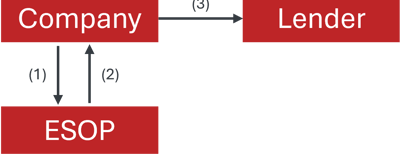Tax-Advantaged Growth: ESOP Strategies for High Payroll Companies
High payroll companies, such as those in industrial services and professional services, can greatly benefit from the tax savings and employee retention advantages of Employee Stock Ownership Plans (ESOPs). This blog explores how ESOPs allow these companies to maximize cash flow through tax-deductible contributions, helping them reinvest in growth and future stability. Learn how leveraging an ESOP can offer significant financial benefits while fostering a culture of ownership and long-term success.
EMPLOYEE OWNERSHIPESOPBUSINESS STRATEGIES
5/1/20244 min read


High payroll companies, such as staffing, industrial services, and professional services firms, are in a unique position to maximize the advantages of an Employee Stock Ownership Plan (ESOP). In addition to the ability to retain top talent, these firms can harness ESOP-related tax deductions to make a more immediate impact on their bottom line. This blog will explore how ESOPs create significant tax savings for high payroll companies and how these companies can strategically use ESOPs to boost cash flow and reinvest in growth.
Corporate ESOP Tax Deductions: A Major Incentive
One of the most significant advantages of employee ownership is the ability to drastically reduce or even eliminate the company’s tax burden. In the case of 100% employee-owned S corporations, the company becomes exempt from federal and state income taxes (with some state exceptions), which creates substantial tax savings.
C corporations that implement leveraged ESOPs also enjoy unique tax incentives. These companies are allowed to claim tax deductions equivalent to the total value of the equity sold to the employee trust. For instance, if 30% of a company is sold for $20 million in an ESOP transaction, the company is entitled to claim $20 million in tax deductions, spread over several years.
Unlocking ESOP Sale Price Deductions
An employee-owned company can make annual contributions to its ESOP trust that are equivalent to 25% of its eligible payroll. These contributions are then used by the ESOP to repay an internal loan, which was initially provided by the company to facilitate the ESOP transaction.
The company makes a tax-deductible contribution or dividends to the ESOP.
The ESOP returns the money to the company to pay down the internal loan in exchange for allocating shares to employees.
The company uses this contribution to make financing payments for the external loan, effectively repaying the ESOP loan with pre-tax dollars.


High Payrolls Accelerate ESOP Tax Benefits
Staffing, industrial services, and professional services firms, including consulting, accounting, engineering, and architecture companies, generally have higher payroll-to-income ratios compared to businesses in other industries. These companies can, therefore, make larger contributions to the ESOP each year, relative to other firms.
For example, if a company with a payroll of $10 million contributes 25% of this amount ($2.5 million) annually to its ESOP, it would receive an equivalent income tax deduction for each contribution. Over time, these companies can tap into their total sale price deduction pool more quickly, significantly reducing their taxable income during the years immediately following the ESOP transaction.
Benefits of Accelerated Tax Deduction Accrual:
Increased cash flow from tax savings can be used for working capital, debt reduction, acquisitions, or growth.
The company can bolster its cash reserves for future investments.
Once a company has exhausted the ESOP sale price tax benefits, it has additional options to extend its ESOP-related tax advantages, including:
Selling more equity to the ESOP to secure new sale price deductions.
Converting to an S corporation, which allows for perpetual tax exemptions on ESOP-owned equity.
Addressing the Cash-to-Accrual Tax Liability
There’s another benefit of ESOPs that high payroll companies, particularly those in staffing and professional services, can leverage. While many of these firms maintain Generally Accepted Accounting Principles (GAAP) financial statements, they report taxes on a cash basis. In such cases, taxes are only paid on cash receipts, which can result in a substantial variance between accrued revenue and accounts receivable.
When companies are acquired by third-party buyers or private equity firms, they are required to adopt accrual accounting, which often results in a sudden recognition of revenue—and a significant tax liability. This liability can reduce the overall value of the sale, cutting into the seller’s proceeds.
An ESOP transaction, however, offers a way to mitigate this tax burden. The ESOP tax deductions discussed earlier can help offset the tax liability that comes from the cash-to-accrual transition. In this way, an ESOP can provide significant protection against the loss of sale proceeds that might occur in a traditional transaction.
Key Considerations and Planning for High Payroll Companies
While the benefits of ESOPs are clear, it’s essential to understand that these tax deductions and advantages are not automatic. Careful planning is required to ensure that an ESOP transaction aligns with a company’s strategic goals, financial position, and tax situation. Companies must work closely with a Certified Employee Ownership Advisor, tax, and accounting advisors to design an ESOP structure that maximizes its potential benefits.
ESOPs also require a long-term commitment. While they can unlock valuable tax savings, the success of the plan depends on the company’s ability to manage its financial obligations and continue creating value for employee-owners over time.
Conclusion: Why ESOPs Are a Powerful Tool for High Payroll Companies
High payroll companies, particularly those in staffing, industrial services, and professional services, are in a prime position to capitalize on the accelerated tax benefits offered by an ESOP. By making larger annual contributions, these companies can tap into significant tax savings more quickly, improving cash flow and enabling reinvestment in growth.
In addition to the tax benefits, ESOPs provide an attractive way to retain top talent, foster a culture of ownership, and ensure long-term company stability. For businesses seeking to reimagine their corporate structure and enhance their financial position, an ESOP may be the solution.
But like any major financial transaction, creating an ESOP requires careful planning and expert guidance. Working with experienced advisors will help ensure that your company maximizes the benefits of employee ownership—both for your employees and for your bottom line.
